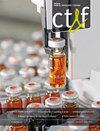保存页岩中膜效率测定方法汇编
IF 0.5
4区 工程技术
Q4 ENERGY & FUELS
引用次数: 4
摘要
膜效率(ME)的测定是研究井筒稳定性化学成分的一个非常有用的工具,因为它是化学弹性模型的一个可变输入(Lomba, Chenevert & Sharma, 2000)。本文提出了一种利用电化学电位测试(EPT)测定页岩中ME的新方法。该方法基于不同溶液浓度下NaCl、KCl和CaCl2存在时离子选择性(is)值的相关性。这种相关性,以前没有在文献中报道过,取决于所使用的盐的类型。EPT是一种通用的测试方法,适用于任何井或盆地的任何岩石类型。它比用于ME测定的其他测试(如压力传递测试(PTT))更简单、更快速。ME和IS之间的相关性适用于任何类型的泥质岩石。使用了属于哥伦比亚不同地层的具有不同性质的未扰动桥塞样品。应用所提出的方法获得的结果表明,应用所开发的相关性,可以通过EPT获得任何类型的泥质岩石的is和ME值。本文章由计算机程序翻译,如有差异,请以英文原文为准。
ASSEMBLY OF A METHODOLOGY FOR DETERMINATION OF MEMBRANE EFFICIENCY IN PRESERVED SHALES
Determination of Membrane Efficiency (ME) is a very useful tool in the study of the chemical component of wellbore stability since it is a variable input in chemical-elastic models (Lomba, Chenevert & Sharma, 2000). This article presents a novel methodology for the determination of ME using the Electrochemical Potential Test (EPT) in shale rocks. This method is based on the development of correlations with Ionic Selectivity (IS) values in presence of NaCl, KCl and CaCl2 at diverse solution concentrations. The correlation, not reported previously in the literature, depends on the type of salt used. The EPT is a generic test easily applied to any rock type from any well or basin. It is simpler and quicker than other tests used for the ME determination, like the Pressure Transmission Test (PTT). Correlations between ME and IS are applicable to any type of argillaceous rock. Samples of unperturbed plugs with diverse properties belonging to different Colombian formations were used. The results obtained with the application of the proposed methodology indicate that it is possible to obtain IS and ME values through EPT in any type of argillaceous rock by applying the developed correlations.
求助全文
通过发布文献求助,成功后即可免费获取论文全文。
去求助
来源期刊

Ct&f-Ciencia Tecnologia Y Futuro
Energy-General Energy
CiteScore
1.50
自引率
0.00%
发文量
7
审稿时长
>12 weeks
期刊介绍:
The objective of CT&F is to publish the achievements of scientific research and technological developments of Ecopetrol S.A. and the research of other institutions in the field of oil, gas and alternative energy sources.
CT&F welcomes original, novel and high-impact contributions from all the fields in the oil and gas industry like: Acquisition and Exploration technologies, Basins characterization and modeling, Petroleum geology, Reservoir modeling, Enhanced Oil Recovery Technologies, Unconventional resources, Petroleum refining, Petrochemistry, Upgrading technologies, Technologies for fuels quality, Process modeling, and optimization, Supply chain optimization, Biofuels, Renewable energies.
 求助内容:
求助内容: 应助结果提醒方式:
应助结果提醒方式:


